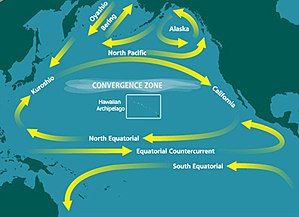The North Pacific Subtropical Gyre (NPSG) is the largest contiguous ecosystem on earth. In oceanography, a subtropical gyre is a ring-like system of ocean currents rotating clockwise in the Northern Hemisphere and counterclockwise in the Southern Hemisphere caused by the Coriolis Effect. They generally form in large open ocean areas that lie between land masses.
The NPSG is the largest of the gyres as well as the largest ecosystem on our planet. Like other subtropical gyres, it has a high-pressure zone in its center. Circulation around the center is clockwise around this high-pressure zone. Subtropical gyres make up 40% of the Earth’s surface and play critical roles in carbon fixation and nutrient cycling.[1] This particular gyre covers most of the Pacific Ocean and comprises four prevailing ocean currents: the North Pacific Current to the north, the California Current to the east, the North Equatorial Current to the south, and the Kuroshio Current to the west. Its large size and distance from shore has caused the NPSG to be poorly sampled and thus poorly understood.[2]

The life processes in open-ocean ecosystems are a sink for the atmosphere’s increasing CO2. Gyres make up a large proportion, approximately 75%, of what we refer to as the open ocean, or the area of the ocean that does not consist of coastal areas. They are considered oligotrophic, or nutrient poor because they are far from terrestrial runoff.[3] These regions were once thought to be homogenous and static habitats. However, there is increasing evidence that the NPSG exhibits substantial physical, chemical, and biological variability on a variety of time scales.[2] Specifically, the NPSG exhibits seasonal and interannual variations in primary productivity (simply defined as the production of new plant material), which is important for the uptake of CO2.
The NPSG is not only a sink for CO2 in the atmosphere, but also other pollutants. As a direct result of this circular pattern, gyres act like giant whirlpools and become traps for anthropogenic pollutants, such as marine debris. The NPSG has become recognized for the large quantity of plastic debris floating just below the surface in the center of the gyre. This area has recently received a lot of media attention and is commonly referred to as the Great Pacific Garbage Patch.